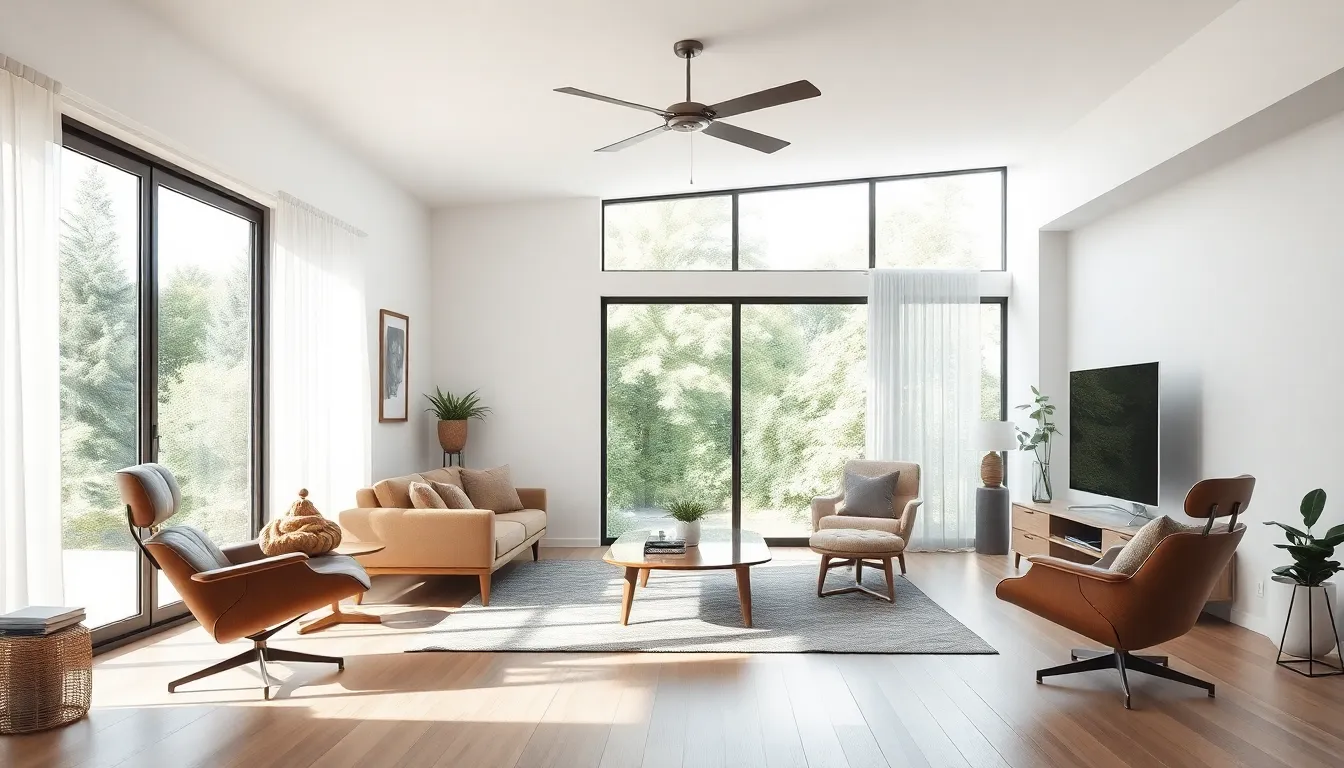Mid-century modern interior design isn’t just a style; it’s a lifestyle that whispers sophistication while winking at whimsy. Picture this: clean lines, organic shapes, and a splash of vibrant color that makes your living room feel like a scene from a retro movie. This design era, which flourished from the 1940s to the 1960s, has made a roaring comeback, proving that good taste never truly goes out of style.
Table of Contents
ToggleOverview of Mid Century Modern Interior Design
Mid-century modern interior design is marked by a unique blend of functionality and aesthetics. This style emphasizes simplicity while incorporating organic forms and vibrant colors. Designers focused on creating open spaces that encourage interaction, often utilizing large windows for natural light.
Furniture plays a crucial role in this design. Iconic pieces display clean lines and minimal ornamentation. Well-known designers, such as Charles and Ray Eames, produced furniture that remains popular today.
Color palettes from this era typically include bold hues combined with earth tones. Such combinations create a warm, inviting atmosphere. Textures also enhance the overall look, with the use of materials like wood, metal, and glass.
The mid-century modern movement also values sustainability. Many designers utilized local materials and crafted pieces meant to last. This focus on durability complements the timeless appeal of the style.
Artistic elements frequently incorporate geometric patterns and abstract shapes. These designs evoke a sense of playfulness, which harmonizes with the overall sophistication of mid-century interiors. Spaces often feature artwork that resonates with the modern aesthetic, enriching the environment.
Lighting designs reflect the era’s innovative spirit. Pendant lights and floor lamps showcase sleek silhouettes, further enhancing the ambiance.
Overall, mid-century modern interior design continues to inspire contemporary spaces. The blend of retro and futuristic elements captivates individuals seeking a unique yet functional living environment.
Key Characteristics of Mid Century Modern Style

Mid-century modern design showcases distinct features that evoke a sophisticated yet playful aesthetic. The style thrives on simplicity, functionality, and a seamless blend with nature.
Clean Lines and Organic Forms
Clean lines dominate mid-century modern interiors, creating an uncluttered look. Organic forms balance these straight edges, introducing a sense of movement. Furniture and architecture often reflect geometric shapes with a focus on elegance. Flat planes and smooth surfaces enhance the visual appeal, making spaces feel open and airy. Combined, these elements promote a harmonious flow. Designers like Eames championed this approach, resulting in iconic pieces that resonate today.
Functionality and Minimalism
Functionality forms the backbone of mid-century modern design. Each piece serves a purpose without unnecessary embellishment. Minimalism plays a crucial role, emphasizing uncluttered spaces that invite ease of movement. Open floor plans often characterize these interiors, encouraging interaction. Natural materials, including wood and metal, contribute to a warm, inviting atmosphere. This practical design ethos fosters an environment where aesthetics meet everyday usability.
Influential Designers and Architects
Mid-century modern interior design features contributions from several key designers and architects who shaped the movement.
Charles and Ray Eames
Charles and Ray Eames significantly influenced mid-century modern design. Their iconic furniture, particularly the Eames Lounge Chair, exemplifies the movement’s integration of form and function. Favoring molded plywood and later fiberglass, their creations brought comfort alongside style. Innovative techniques like splint molding transformed how furniture manufacturing progressed. Collaboration between the couple resulted in groundbreaking designs that merged artistry with practicality. This dedication to the user experience ensured their pieces remain highly sought after.
George Nelson
George Nelson played a pivotal role in defining mid-century modern interiors. Known for his versatile designs, Nelson emphasized functionality and aesthetic appeal. The Nelson Platform Bench became a hallmark piece, showcasing minimalist elegance. His efforts in furniture, storage solutions, and lighting defined modern living spaces. Embracing modularity, Nelson’s designs encouraged creativity in arrangements and styles. Iconic products such as the Bubble Lamp exhibit his innovative spirit, contributing to the era’s lasting legacy.
Popular Materials and Colors
Mid-century modern interior design features a distinctive selection of materials and colors that contribute to its timeless appeal. Emphasis on natural elements creates warmth and connection in living spaces.
Wood and Metal Elements
Wood remains a central material, with species like teak, walnut, and oak commonly used in furniture and cabinetry. Rich tones enhance the rustic charm of interiors while providing durability. Metal accents, such as stainless steel and chrome, introduce a sleek contrast. Designers often combine these elements to create visually striking pieces, reflecting the era’s innovative spirit. Iconic furniture like the Eames Lounge Chair showcases the seamless integration of wood and metal, highlighting both functionality and style.
Bold and Muted Color Palettes
Color palettes in mid-century modern design are diverse, ranging from bold hues to muted tones. Vibrant colors like orange, avocado green, and mustard yellow create eye-catching focal points, often used in textiles and wall art. Muted earth tones, such as browns, grays, and soft blues, provide a calming balance. This combination promotes a harmonious atmosphere, connecting interior spaces with the outdoor environment. Accessories such as cushions or rugs allow for playful pops of color while maintaining a cohesive design.
Incorporating Mid Century Modern Design in Your Home
Incorporating mid-century modern design in homes emphasizes functionality and style. Choose furniture pieces that embody clean lines and organic shapes, such as an Eames Lounge Chair or a Nelson Platform Bench. These iconic items combine form and function, seamlessly fitting into various living spaces.
Use a color palette that includes bold hues like orange and avocado green alongside muted earth tones. These colors create a warm and inviting atmosphere. Accent walls or decorative accessories like cushions and rugs offer an opportunity for playful color pops while keeping a unified design theme.
Select materials that reflect the mid-century ethos, focusing on wood species such as teak, walnut, or oak. These choices provide durability and warmth. Incorporate metal accents, including stainless steel and chrome, to introduce a sleek contrast that enhances the overall aesthetic.
Lighting plays a vital role in mid-century modern spaces. Opt for pendant lights or sculptural floor lamps that showcase innovative designs. Such fixtures illuminate rooms while adding artistic flair.
Consider incorporating geometric patterns and abstract shapes through textiles and artwork. These elements evoke a sense of playfulness while maintaining an elegant ambiance. Integrating plants into the décor also merges the indoors with nature, aligning with mid-century design principles.
Utilize open spaces that promote interaction and flow among rooms. Large windows allow natural light to flood in, enhancing the overall atmosphere. By prioritizing simplicity and functionality, homeowners can craft an inviting environment that resonates with mid-century modern aesthetics.
Mid-century modern interior design remains a powerful influence in contemporary spaces. Its unique blend of functionality and aesthetic appeal continues to captivate homeowners and designers alike. By embracing clean lines organic shapes and vibrant colors this style fosters an inviting atmosphere that encourages interaction and creativity.
Incorporating elements of mid-century modern design not only enhances a home’s visual appeal but also promotes a sustainable lifestyle through the use of durable materials. As this timeless style continues to evolve it proves that sophistication and playfulness can coexist beautifully in any living environment. Embracing mid-century modern principles can transform spaces into harmonious retreats that celebrate both form and function.





